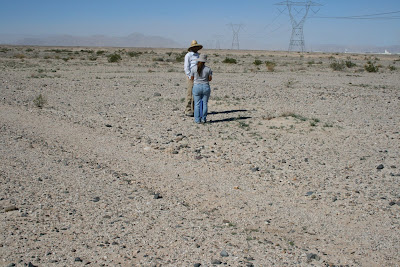 One of the things I have found fascinating about archaeology here in the Yuha Desert are the prehistoric trails that criss-cross the area. They are quite common and easily distinguishable from trails made by modern vehicles. As with the lithic scatters and pot drops I posted about earlier, it’s astonishing how long things can stay intact here. You can plainly see one just below my two crew members in this picture. So many rocks have been kicked over to the side of the trail they almost form kerbs. I suppose if you were walking barefoot or in yucca sandals across the desert pavement you’d be kicking rocks out of the way, too. The trails are the result of hundreds of years of this sort of thing.
One of the things I have found fascinating about archaeology here in the Yuha Desert are the prehistoric trails that criss-cross the area. They are quite common and easily distinguishable from trails made by modern vehicles. As with the lithic scatters and pot drops I posted about earlier, it’s astonishing how long things can stay intact here. You can plainly see one just below my two crew members in this picture. So many rocks have been kicked over to the side of the trail they almost form kerbs. I suppose if you were walking barefoot or in yucca sandals across the desert pavement you’d be kicking rocks out of the way, too. The trails are the result of hundreds of years of this sort of thing.
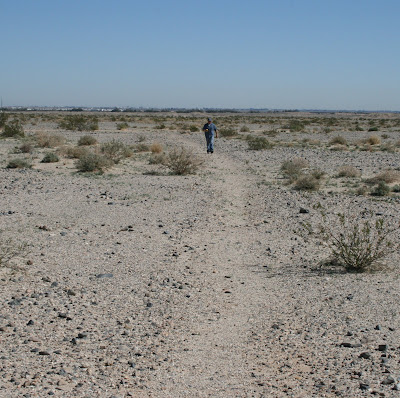 This picture shows the trail plainly curving off to the northeast, heading to the old Lake Cahuilla shoreline. My colleague Josh is walking this stretch of the trail with his GPS unit in hand to map the route. When the fieldwork is complete, we’ll use the GIS data on the routes along with high-resolution air photos to link the segments up and make a prehistoric road map.
This picture shows the trail plainly curving off to the northeast, heading to the old Lake Cahuilla shoreline. My colleague Josh is walking this stretch of the trail with his GPS unit in hand to map the route. When the fieldwork is complete, we’ll use the GIS data on the routes along with high-resolution air photos to link the segments up and make a prehistoric road map.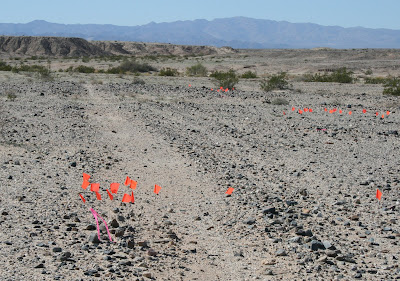 As one would expect, there is evidence of lots of prehistoric activity along these trails. The picture above shows distinct activity areas near this trail by clusters of pin flags marking artifact locations.
As one would expect, there is evidence of lots of prehistoric activity along these trails. The picture above shows distinct activity areas near this trail by clusters of pin flags marking artifact locations.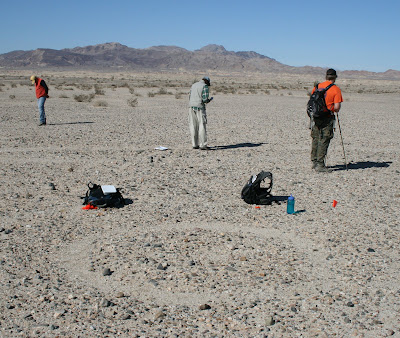 It also appears that the trails weren’t simply utilitarian facilities, but also served ritualistic purposes. We have found a number of circles near trails, like the one above…
It also appears that the trails weren’t simply utilitarian facilities, but also served ritualistic purposes. We have found a number of circles near trails, like the one above… 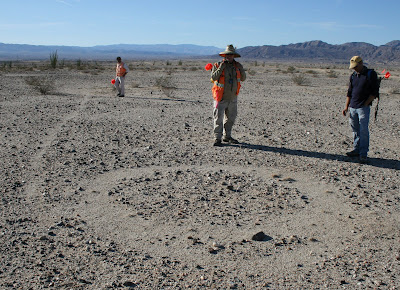 …and this one which has its own small path linking it to the trail in the background. It is likely that these are related to what the local ethnographic literature calls power circles. The power circles were used by travelers along the trail, both during actual travel and “dream travel” (during trances) to pray and meditate to obtain power for the successful completion of the journey. A recent archaeological project conducted nearby used a Least Cost Digital Elevation Model to plot hypothetical extensions of known trail segments. The reasoning here was that people using the trails would take the shortest and easiest routes between points. Field checks showed that the model was a poor predictor of trail locations – the presumption being that trails were routed to link important ritual locations rather than following the physically easiest route.
…and this one which has its own small path linking it to the trail in the background. It is likely that these are related to what the local ethnographic literature calls power circles. The power circles were used by travelers along the trail, both during actual travel and “dream travel” (during trances) to pray and meditate to obtain power for the successful completion of the journey. A recent archaeological project conducted nearby used a Least Cost Digital Elevation Model to plot hypothetical extensions of known trail segments. The reasoning here was that people using the trails would take the shortest and easiest routes between points. Field checks showed that the model was a poor predictor of trail locations – the presumption being that trails were routed to link important ritual locations rather than following the physically easiest route.
Reid-
Very cool and pretty darned mysterious- take time out of a trip across the desert to travel in circles? Different perspective, for sure. Reading this, I wonder how many features I’ve passed that are really ancient but that I failed to appreciate as such.